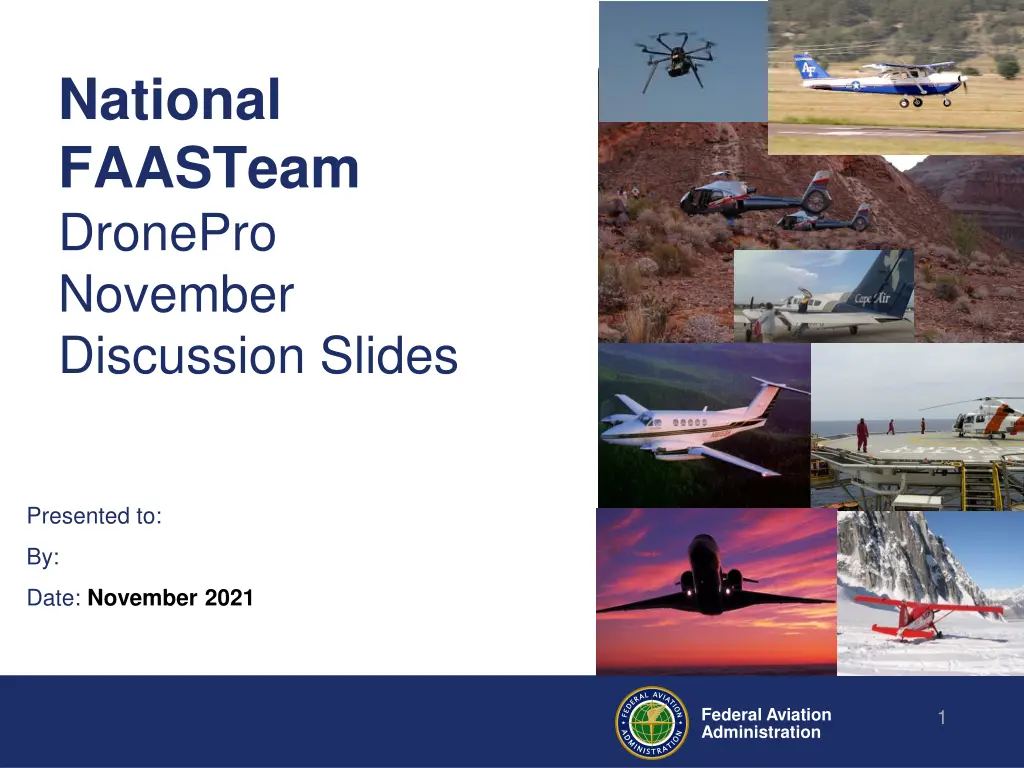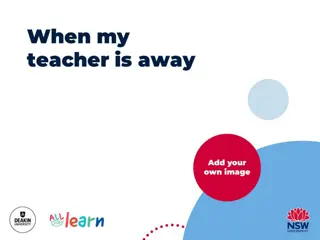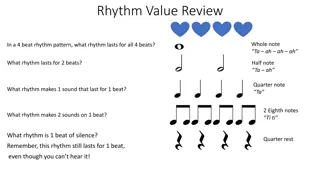
FAA Drone Regulations Update & Compliance Guidelines
Stay compliant with FAA regulations by understanding the latest updates impacting drone operations. Learn about airspace notification requirements, drone compliance categories, night flying waivers, and more. Ensure safe and legal drone operations with this comprehensive guide.
Uploaded on | 1 Views
Download Presentation

Please find below an Image/Link to download the presentation.
The content on the website is provided AS IS for your information and personal use only. It may not be sold, licensed, or shared on other websites without obtaining consent from the author. If you encounter any issues during the download, it is possible that the publisher has removed the file from their server.
You are allowed to download the files provided on this website for personal or commercial use, subject to the condition that they are used lawfully. All files are the property of their respective owners.
The content on the website is provided AS IS for your information and personal use only. It may not be sold, licensed, or shared on other websites without obtaining consent from the author.
E N D
Presentation Transcript
National FAASTeam DronePro November Discussion Slides Presented to: By: Date: November 2021 Federal Aviation Administration 1
Whats the story with Rec Flyers notifying airports before flight? That notification requirement went away in 2018 with the FAA Reauthorization Act (Public Law 115- 254) Since 2018, rec flyers must obtain an airspace authorization before operating in controlled airspace Airspace authorizations are obtained via LAANC or DroneZone Must be at or below UASFM altitudes No airspace authorization needed in Class G airspace No airport notification See 49 USC 44809 or Advisory Circular 91-57 Federal Aviation Administration 2
Is public safety exempt from the requirement to use a CAT 2 or CAT 3 compliant (and marked) drone to conduct a CAT 2 or CAT 3 operation over people? Public Safety is not exempt Category Operations are part 107 If flying under part 107, a remote pilot, including public safety, may only operate over people with an approved, compliant and marked (if CAT 2, 3, or 4) Category drone, appropriate to the category of operation over people If flying under a part 91 COA, public safety COAs only allow for flights over people in a life safety (life or death) situation, and only momentarily (not sustained) Federal Aviation Administration 3
How do I know if my drone is CAT 2 or CAT 3 compliant? It must be listed on the FAA Declaration of Compliance Accepted webpage If it s not listed there, it s not approved for CAT 2 or CAT 3 ops CAT 4 ops requires a Type Certificated drone https://uasdoc.faa.gov If you want to fly over people today, you can only use a CAT 1 drone since none are approved yet for CAT 2 or CAT 3 (or CAT 4) operations Federal Aviation Administration 4
Are waivers to 107.29 (night) still valid? All waivers to 107.29 were terminated by the FAA as of 17 May 2021 Any part 107 remote pilot can fly at night without a waiver provided they have completed the updated recency of knowledge training or initial test, and equipped the drone with anti-collision lighting that s visible for 3SM No change to the Part 91 COAs, however *NOTE: A waiver to 107.29 is still possible but only to waive lighting requirements Federal Aviation Administration 5
Does 107.29 establish night Visual Line Of Sight (VLOS) criteria? No. The VLOS criteria are found in 107.31 107.29 essentially establishes pre- requisites to operate at night, ...and gives the RPIC the ability to turn down the intensity of light for safety reasons for that particular flight 107.29 does not establish VLOS criteria at all 107.29 and 107.31 are like apples and oranges NOTE: The 3SM lighting requirement stated in 107.29 is there so manned aviators can see the drone and maneuver in a timely manner, not so the drone pilot can fly their drone up to 3SM away and claim VLOS Federal Aviation Administration 6
What are the VLOS criteria of 107.31? Notice the reg doesn t say ...in _____ conditions... Throughout the entire flight, with vision unaided by any device other than corrective lenses (spectacles), the Remote Pilot must be able to see the drone well enough to know its: Location Altitude Attitude Direction of Flight Observe airspace for other traffic Not pose a hazard to others That s because the VLOS criteria are applicable in all conditions Federal Aviation Administration 7
Handy UAS References https://www.faa.gov/uas UASHelp@faa.gov or 844-FLY-MYUA FAA Rules are found in Title 14 of the US Code of Federal Regulations: https://www.ecfr.gov/ FAA Advisory Circulars (AC) https://www.faa.gov/regulations_policies/adv isory_circulars/ AC 91-57 AC 107-2A Federal Aviation Administration 8
Is a preflight required for a drone flight? The answer depends on which rules govern the flight For 49 USC 44809 (Exception for Limited Rec Flyers) flights 49 USC 44809 flights must comply with CBO safety guidelines See also AC 91-57B for FAA Interim Safety Guidelines No preflight is explicitly required in 44809 Federal Aviation Administration 9
Is a preflight required for a drone flight? Yes, if it is a part 91 flight Part 91.7(b) applies to civil operators such as 44807 and SAC-EC flights- No person may operate a (civil) aircraft unless it s in a safe condition for flight Part 91.103 applies to both civil and public operators- Each pilot in command shall, before beginning a flight, become familiar with all available information concerning that flight... Part 91 certificates of waiver/authorization (COAs) also require a preflight to include specific aircraft and control station systems checks, to ensure the small UAS is in a condition for safe operation Federal Aviation Administration 10
Is a preflight required for a drone flight? Appendix E of AC 107- 2A has a three page sample checklist Yes, if it is a part 107 flight Part 107.49 requires the RPIC to: Check local weather Check airspace Inspect and confirm functionality of drone and GCS Confirm location of persons and property on the ground Check for other ground hazards Brief crew , and more.... See AC 107-2A, Chapter 5 and Appendices Federal Aviation Administration 11
Are there minimum weather requirements for flying a drone? The answer depends on which rules govern the flight 49 USC 44809 has no weather minimums, but requires the operator to follow the safety guidelines of a CBO or the FAA s interim guidelines (see AC 91-57B) Part 91.155 Basic VFR Minimums (depends on which class of airspace) Part 91 COAs also say 3SM minimum visibility from ground control station (GCS) Part 107.51(c) says 3 SM visibility from GCS Minimum distance a drone may be flown from clouds is 500 below and 2000 horizontally Fog is a cloud at ground level Federal Aviation Administration 12
Whats the difference between a FRIA and a Fixed Site? FAA Recognized Identification Area (FRIA) A specific geographic area that drone and operator must remain within, where RID is not required Tied to the implementation of Remote ID FAA-recognized CBOs and Educational Institutions may apply for FRIA status Application review criteria under development None expected to become established until September 2022 at the earliest Fixed Site A specific geographical area in controlled airspace, subject to a Letter of Agreement (LOA) between a RC flying club and the local ATC facility Fixed Sites are currently in use now, in controlled airspace or where a flying club has an altitude restriction higher than 400 AGL Fixed Sites are depicted by small blue circles on the UASFM ArcGIS Map https://www.faa.gov/go/uasdata RID will be required to fly here (when RID becomes mandatory) Federal Aviation Administration 13






















